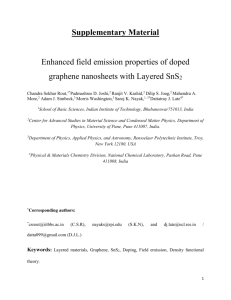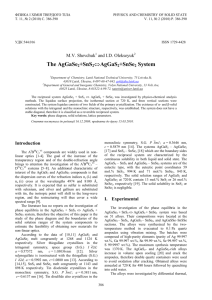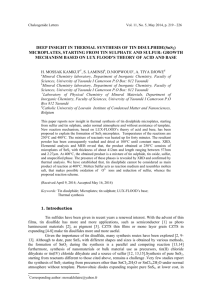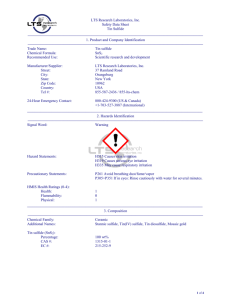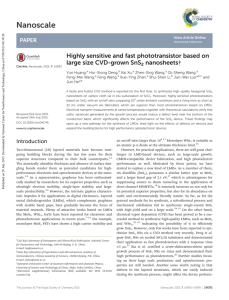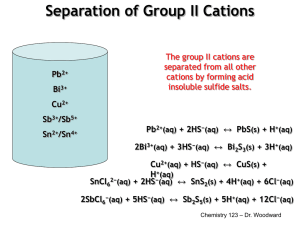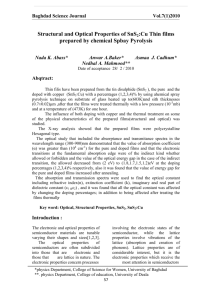Full Text PDF
advertisement
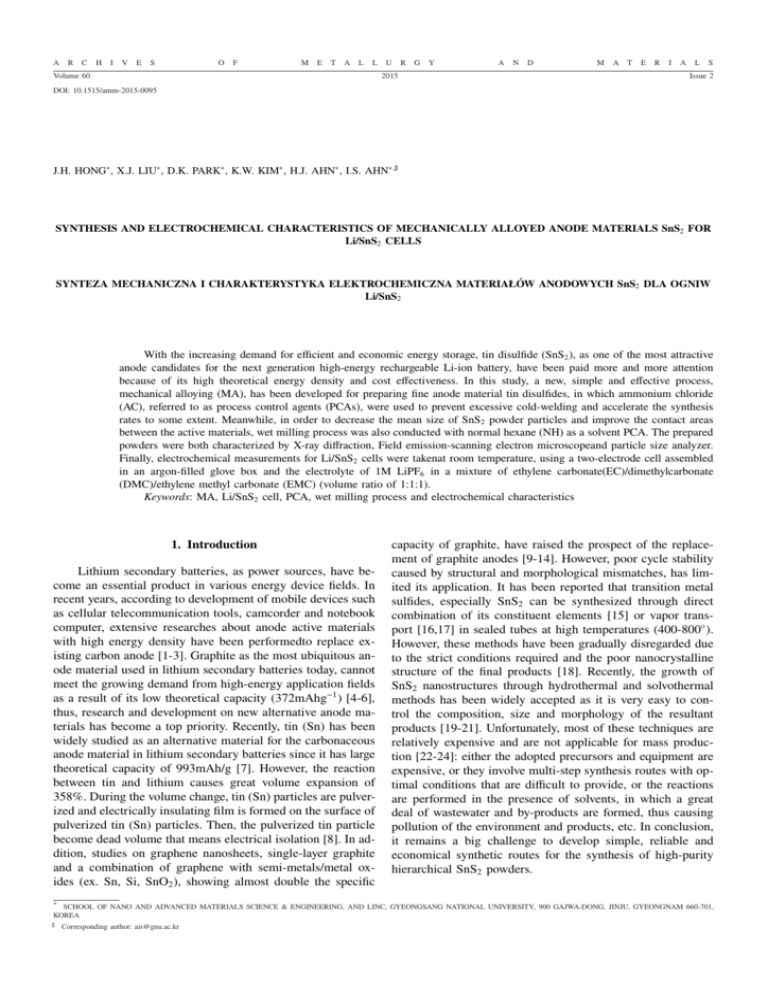
A R C H I V E S O F M E T A L L Volume 60 U 2015 R G Y A N D M A T E R I A L S Issue 2 DOI: 10.1515/amm-2015-0095 J.H. HONG∗ , X.J. LIU∗ , D.K. PARK∗ , K.W. KIM∗ , H.J. AHN∗ , I.S. AHN∗,] SYNTHESIS AND ELECTROCHEMICAL CHARACTERISTICS OF MECHANICALLY ALLOYED ANODE MATERIALS SnS2 FOR Li/SnS2 CELLS SYNTEZA MECHANICZNA I CHARAKTERYSTYKA ELEKTROCHEMICZNA MATERIAŁÓW ANODOWYCH SnS2 DLA OGNIW Li/SnS2 With the increasing demand for efficient and economic energy storage, tin disulfide (SnS2 ), as one of the most attractive anode candidates for the next generation high-energy rechargeable Li-ion battery, have been paid more and more attention because of its high theoretical energy density and cost effectiveness. In this study, a new, simple and effective process, mechanical alloying (MA), has been developed for preparing fine anode material tin disulfides, in which ammonium chloride (AC), referred to as process control agents (PCAs), were used to prevent excessive cold-welding and accelerate the synthesis rates to some extent. Meanwhile, in order to decrease the mean size of SnS2 powder particles and improve the contact areas between the active materials, wet milling process was also conducted with normal hexane (NH) as a solvent PCA. The prepared powders were both characterized by X-ray diffraction, Field emission-scanning electron microscopeand particle size analyzer. Finally, electrochemical measurements for Li/SnS2 cells were takenat room temperature, using a two-electrode cell assembled in an argon-filled glove box and the electrolyte of 1M LiPF6 in a mixture of ethylene carbonate(EC)/dimethylcarbonate (DMC)/ethylene methyl carbonate (EMC) (volume ratio of 1:1:1). Keywords: MA, Li/SnS2 cell, PCA, wet milling process and electrochemical characteristics 1. Introduction Lithium secondary batteries, as power sources, have become an essential product in various energy device fields. In recent years, according to development of mobile devices such as cellular telecommunication tools, camcorder and notebook computer, extensive researches about anode active materials with high energy density have been performedto replace existing carbon anode [1-3]. Graphite as the most ubiquitous anode material used in lithium secondary batteries today, cannot meet the growing demand from high-energy application fields as a result of its low theoretical capacity (372mAhg−1 ) [4-6], thus, research and development on new alternative anode materials has become a top priority. Recently, tin (Sn) has been widely studied as an alternative material for the carbonaceous anode material in lithium secondary batteries since it has large theoretical capacity of 993mAh/g [7]. However, the reaction between tin and lithium causes great volume expansion of 358%. During the volume change, tin (Sn) particles are pulverized and electrically insulating film is formed on the surface of pulverized tin (Sn) particles. Then, the pulverized tin particle become dead volume that means electrical isolation [8]. In addition, studies on graphene nanosheets, single-layer graphite and a combination of graphene with semi-metals/metal oxides (ex. Sn, Si, SnO2 ), showing almost double the specific ∗ capacity of graphite, have raised the prospect of the replacement of graphite anodes [9-14]. However, poor cycle stability caused by structural and morphological mismatches, has limited its application. It has been reported that transition metal sulfides, especially SnS2 can be synthesized through direct combination of its constituent elements [15] or vapor transport [16,17] in sealed tubes at high temperatures (400-800◦ ). However, these methods have been gradually disregarded due to the strict conditions required and the poor nanocrystalline structure of the final products [18]. Recently, the growth of SnS2 nanostructures through hydrothermal and solvothermal methods has been widely accepted as it is very easy to control the composition, size and morphology of the resultant products [19-21]. Unfortunately, most of these techniques are relatively expensive and are not applicable for mass production [22-24]: either the adopted precursors and equipment are expensive, or they involve multi-step synthesis routes with optimal conditions that are difficult to provide, or the reactions are performed in the presence of solvents, in which a great deal of wastewater and by-products are formed, thus causing pollution of the environment and products, etc. In conclusion, it remains a big challenge to develop simple, reliable and economical synthetic routes for the synthesis of high-purity hierarchical SnS2 powders. SCHOOL OF NANO AND ADVANCED MATERIALS SCIENCE & ENGINEERING, AND LINC, GYEONGSANG NATIONAL UNIVERSITY, 900 GAJWA-DONG, JINJU, GYEONGNAM 660-701, KOREA ] Corresponding author: ais@gnu.ac.kr 1192 In this study, we prepared tin sulfide powder by mechanical alloying using tin powder and sulfur powder. Here, a process control agent (PCA), also referred to as a lubricant or surfactant, is added to the powder mixture during milling to reduce the effect of excessive cold-welding, as true alloying among powder particles can only occur when a balance is maintained between cold-welding and the fracturing of powder particles. Furthermore, the nature and amount of the PCA can greatly affect the powder particle size, grain sizeand even electrochemical activity, further affecting the cycle characteristics when used as anode materials. 2. Experimental procedure 2.1. Materials Raw materials of tin powder (Sn, 99.9%, -325mesh) and sulfur powder (S, 99.9%, -100mesh) were purchased from Sigma-Aldrich Corporation, PCAs of ammonium chloride (NH4 Cl, >99.5%) and normal hexane (CH3 (CH2 )4 CH3 , 95.0%) were purchased from Samchun Pure Chemical Co., LTD. All chemicals except for hexane were dried in oven at 60◦ for 24h to remove water molecules adsorbed on the surface of the raw materials. 2.2. Synthesis of Anode Materials According to the chemical formula for SnS2 , the raw materials (tin & sulfur) and grinding medium (stainless steel balls, 5 mm) were placed together into a jar in an argon-filled glove box. The atomic ratio of tin/sulfur is 1:2, the ball-to-powder ratio (BPR) is 20:1. process control agents (PCA-ammonium chloride (NH4 Cl)) and stirring was applied to wash off NH4 Cl with distilled water. And the only differencewas added to wet milling process. Wet milling was conducted to decrease the mean particle size. After wet milling process and stirring, then dried at 60 degree under vacuum for 24hrs. In order to distinguish these two final products prepared for electrochemical testing, the former one using Ammonium Chloride (AC) is named SnS2 -AC and the latter one added wet milling process is named SnS2 -ACW. 2.3. Manufacture of Anode The working electrodes were prepared by dispersing the active materials (SnS2 -AC, SnS2 -ACW), conductor (Super-P) and binder ((polyvinylidene fluoride) (PVDF)) into the organic solvent (N-Methylpyrrolidone (NMP)) with a mass ratio of 80:10:10. Then the homogeneous slurry was coated over the copper foil using a doctor-blade casting method, and dried in a vacuum oven for 24h. Furthermore, electrochemical measurements were taken using a two-electrode cell assembled in an argon-filled glove box, in which lithium was used as the counter and reference electrode, and a microporous polypropylene membrane of Celgard 2400 was used as a separator. The electrolyte was made by dissolving 1 M LiPF6 in a mixture of ethylene carbonate (EC)/dimethyl carbonate (DMC)/ethylene methyl carbonate (EMC) (volume ratio of 1:1:1). 2.4. Structure and morphology characterization XRD measurements were carried out using a Philips PW3710 with Cu Kα radiation (RIGAKU, D/MAX-2500,λ =1.5405Å). HELOS Particle Size Analysis was used to measure the size distribution, mean particle size and specific area of the alloyed powder, ranging from 250nm to 87.5µm. 2.5. Electrochemical measurements The charge/discharge measurements were taken on a WBCS 3000 Battery Tester between 0.01V and 2.5V, while cyclic voltammetry (CV) was conducted on a redefining electrochemical measurement at a scan rate of 0.1mVs−1 between 0.01V and 2.5V vs. Li+ /Li at room temperature. 3. Results and discussion Fig. 1. Schematic of experimental procedure Fig. 1 shows schematic of experimental procedure,in this study, two kinds of SnS2 have been prepared through almost the same drying, mixing, mechanical alloying process, used Fig. 2 shows SEM micrographs of the starting materials of (a) sulfur, (b) tin, (c) NH4 Cl. Fig. 2 shows the original surface morphologies of the raw materials of tin and sulfur used in the experiment. The spherical shaped tin powders have a good size distribution, with the mean size of 16um shown in Fig. 2 (a), meanwhile the irregular shape of sulfur particles, which are relatively bigger were shown in Fig. 2 (b), and NH4 Cl with big particle size show in Fig. 2 (c). Fig. 3 is the SEM micrographs of synthesized SnS2 before and after wet milling, respectively. Clearly, the particle size was greatly decreased through wet milling process. 1193 Fig. 2. SEM micrographs of the starting materials of (a) sulfur, (b) tin and (c) NH4 Cl at 2.5h did not change much except for the disappearance of the small sulfur peaks, suggesting a complete reaction between the elemental reactants. The lack of any NH4 Cl peaks in the patterns of the stirred products confirmed that NH4 Cl was completely washed off through stirring. For SnS2 -ACW, the pattern is same with the sample of SnS2 -AC, indicating that there were no impurities formed during the wet-milling process by comparing the wet-milled patterns with the same JCPDS card. The cumulative distribution and density distribution curves for stirred SnS2 -AC, and wet-milled SnS2 -ACW powders are shown in Fig. 5 (a) and (b), respectively. Since the abscissa value of particle size corresponding to the ordinate value-50% of the cumulative distribution is defined as the mean particle size, according to the dotted line position, the average size of the above-mentioned powders are considered to be 7.66 um and 1.85 um. Obviously, wet-milling can not only disperse the agglomerated powder particles into small ones, but also improve their size distribution at the same time. The cumulative distribution curve of wet-milledSnS2 -ACW has always been on top of the dry milled one, suggesting the refinement of overall particles after wet ball milling.Referring to the density distribution curves, while stirred SnS2 -AC and wet-milled SnS2 -ACW have only one big peak respectively, indicating their good size distribution, which is conducive to the latter’s electrochemical performance. Fig. 3. SEM micrographs of synthesized SnS2 before and after wet milling Fig. 5. Cumulative and density distribution curves of alloyed SnS2 powders before and after wet milling process Fig. 4. XRD patterns of mechanical alloyed SnS2 powders with different milling times in the MA process and centrifugation and wet milling process The crystal structures and phase transition of the as-prepared samples (SnS2 -AC, ACW) were confirmed by XRD. Fig. 4 shows XRD patterns of mechanical alloyed SnS2 powders with different milling times in the MA process, centrifugation and wet milling process. For SnS2 -AC, not only broad SnS2 peaks and small sulfur peaks were detected after 1h of milling, but also sharp NH4 Cl peaks, and the pattern Fig. 6. The initial charge/discharge curves of Li/ SnS2 -AC and Li/SnS2 -ACW cells The initial charge/discharge curves of Li/SnS2 -AC and Li/SnS2 -ACW cells shown in Fig. 6 were measured with a current density of 90mAg−1 between 0.01V and 2.5V, and 1194 their corresponding charge/discharge capacities are 1021/1535 and 927/1322 mAhg−1 ranged in a diminishing sequence from SnS2 -AC to SnS2 -ACW. And the irreversible capacities are attributed to the incomplete conversion reaction and irreversible loss of lithium ions due to the formation of Li2 O and SEI. The cycling performance were tested and shown in Fig. 7, clearly, the cell Li/SnS2 -AC manifested extraordinary cycling behavior and retained a higher reversible capacity of 160 mAhg−1 after 50 cycles, while for the cell of Li/SnS2 -ACW, only 18mAhg-1was remained, mainly due to the long milling time. As known, the longer the milling conducted, the lower the crystallinity, therefore, the worse the cycling performance. In addition, another result that crystallinity played a much more important role than mean particle size on cycling performance can be obtained. Although the cycling performance is not so good when compared with other previousreports, AC, as an inorganic process control agent, was successfully applied into MA for the first time. Compared with the common organic SA, it not only can improve the crystallinity of synthesized tin sulfides, also shorten the milling time, thus providing a new way to prepare a series of metal sulfides in the future. Fig. 7. The cycling performance of Li/ SnS2 -AC and Li/SnS2 -ACW cells at room temperature 4. Conclusion SnS2 powder particles were synthesized through a new, simple and effective MA process, in which AC was used as a PCA to improve the alloying process at different levels and simultaneously affect the material properties. The structure, morphology and electrochemical performance of the as-synthesized powders were characterized by XRD, HELOS Particle Size Analyzer,and charge/discharge measurements. The stirred SnS2 -AC, with better crystallinity but larger mean Received: 20 November 2014. particle size, presents a better reversible capacity and cycling performance than that of the wet-milled SnS2 -SA, mainly due to its better crystal structural stability. Acknowledgements This research was supported by the National Research Foundation of Korea (NRF) grant funded by the Korea government (MEST) (No. 2012R1A2A2A02015831) and the Gyeongsang National University Fund for Professors on Sabbatical Leave, 2013. REFERENCES [1] Y.Li, J.P. Tu, H.M. Wu, Y.F. Yuan, D.Q. Shi, Mater. Sci. Eng. B 128, 75 (2006). [2] X. Liu, H.J. Ahn, I.S. Ahn, J. Kor. Powd. Met. Inst. 19, 182 (2012). [3] J.W. Song, Otaduy Guilermo, S.J Hong, J. Kor. Powd. Met. Inst. 19, 226 (2012). [4] M. Winter, R.J. Brodd, Chem. Rev. 104, 4245 (2004). [5] Y.P. Wu, C. Jiang, C. Wu, R. Holze, Solid State Ionics 156, 283 (2003). [6] W.J. Zhang, J. Power Sources 196, 13 (2011). [7] Q.F. Dong, C.Z. Wu, M.G. Jin, Z.C. Huang, Solid State Ionics, 167, 49 (2004). [8] Y.Li, J.P. Tu, X.H. Houang, H.M Wu, Y.F. Yuan, Electrochim. Acta 52, 1383 (2006). [9] A.K. Geim, K.S. Novoselov, Nat. Mater. 6, 183 (2007). [10] E. Yoo, J. Kim, E. Hosono, H. Zhou, T. Kudo, I. Honma, Nano Lett. 8, 2277 (2008). [11] B. Wang, X.L. Wu, C.Y. Shu, Y.G. Guo, C.R. Wang, J. Mater. Chem. 20, 10661 (2010). [12] M. Pumera, Chem. Rec. 9, 211 (2009). [13] G.X. Wang, X.P. Shen, J. Yao, J. Park, Carbon 47, 2049 (2009). [14] Y.Q. Sun, Q.O. Wu, G.Q. Shi, Energ. Environ. Sci. 4, 1113 (2011). [15] P.W. Shen, J.T. Wang, Dictionary of Compounds, Lexicographical Publishing House, Shanghai, 2002. [16] S.K. Arora, D.H. Patel, M.K. Agarwal, Mater. Chem. Phys. 45, 63 (1996). [17] K. Kourtakis, J. DiCarlo, R. Kershaw, K. Dwight, A. Wold, J. Solid State Chem. 96, 186 (1988). [18] H. Xiao, Y.C. Zhang, H.X. Bai, Mater. Lett. 63, 809 (2009). [19] Y.C. Zhang, Z.N. Du, M. Zhang, Mater. Lett. 65, 2891 (2011). [20] Y.C. Zhang, J. Li, M. Zhang, D.D. Dionysiou, Environ. Sci. Technol. 45, 9324 (2011). [21] Y.C. Zhang, Z.N. Du, K.W. Li, M. Zhang, Sep. Purif. Technol. 81, 101 (2011). [22] B. Hai, K. Tang, C. Wang, C. An, Q. Yang, Y. Qian, J. Cryst. Growth 225, 92 (2001). [23] X.L. Gou, J. Chen, P.W. Shen, Mater. Chem. Phys. 93, 557 (2005). [24] Q. Yang, K. Tang, C. Wang, D. Zhang, Y. Qian, J. Solid State Chem. 164, 106 (2002).
